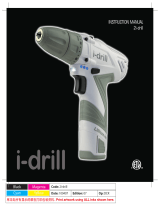
11
MAINTENANCE
WARNING!
To reduce the risk of injury,
always unplug the charger and
remove the battery pack from
the charger or tool before
performing any maintenance.
Never disassemble the tool,
battery pack or charger. Contact
a
MILWAUKEE
service facility for
ALL repairs.
Keep your tool, battery pack and charger
in good repair by adopting a regular main-
tenance program. After six months to one
year, depending on use, return the
tool, battery pack and charger to a
MILWAUKEE
service facility for:
• Lubrication
• Mechanical inspection and cleaning
(gears, spindles, bearings, housing,
etc.)
• Brush inspection and replacement
• Electrical inspection (battery pack,
charger, motor)
• Testing to assure proper mechanical
and electrical operation
Maintaining Tool
If the tool does not start or operate at full
power with a fully charged battery pack,
clean the contacts on the battery pack. If
the tool still does not work properly, return
the tool, charger and battery pack, to a
MILWAUKEE
service facility for repairs.
Maintaining Battery Pack
MILWAUKEE
battery packs will operate
for many years and/or hundreds of cycles
when they are maintained and used ac-
cording to these instructions.
A battery pack that is stored for six months
without being used will discharge itself.
Batteries discharge at a rate of about 1%
per day. Charge the battery every six
months even if it is unused to maximize
battery life. Do not tape the trigger in the
“ON” position and leave the tool unattended
as this may discharge the battery to a point
where it will no longer be able to recharge.
Use a
MILWAUKEE
battery pack only until
it no longer performs with the power and
torque needed for your application.
Store your battery pack in a cool, dry place.
Do not store it where the temperature may
exceed 120°F (50°C) such as a vehicle or
metal building during the summer. High tem-
peratures will overheat the battery pack,
reducing battery life. If it is stored for sev-
eral months, the battery pack will gradu-
ally lose its charge. One to three cycles of
charging and discharging through normal
use will restore the capacity of the battery
pack. During the life of the battery pack the
operating time between charges becomes
shorter. If the operating time becomes ex-
tremely short after a proper charge, the
usable life of the battery pack has been
reached and it should be replaced.
WARNING!
To reduce the risk of personal
injury and damage, never
immerse your tool, battery pack
or charger in liquid or allow a
liquid to flow inside them.
Cleaning
Clean dust and debris from charger and
tool vents. Keep tool handles clean, dry
and free of oil or grease. Use only mild
soap and a damp cloth to clean the tool,
battery pack and charger since certain
cleaning agents and solvents are harmful
to plastics and other insulated parts. Some
of these include gasoline, turpentine, lac-
quer thinner, paint thinner, clhlorinated
cleaning solvents, ammonia and household
detergents containing ammonia. Never use
flammable or combustible solvents around
tools.
















